|
Contributed by: Slowhand
Having struggled mightily with cloning for quite
a while, I have settled on a method that works 100% (so
far) for me. This is ONLY for soil growing, there are a
lot of ways to clone for hydroponics but this is not
one. This simple and reliable cloning method is for all
you newbie or just unlucky cloners, and it does not
require any close supervision.
If you are having
cloning problems, please try it like this:
The
"key" to my problem was my great difficulty to get roots
before damp off problems, etc. Oasis recommends that the
cubes be sat in shallow nute solution and left there. I
found that was far too wet for oxygen hungry MJ. To
"buffer" the cube, we shall use regular soil mix that is
kept moist, rather than standing in water. This will
allow much more oxygen to the rooting area.
Lets get started:
Start with standard
3" seedling pots (I prefer the very thin and flexible
breeders pots found in large flats), some Oasis cubes,
and a sharp box cutter or knife.
Have your soil
mix prepared and ready.
I use:
60% Scotts
seedling starter mix
15% worm castings
10%
vermiculite
10% perlite
5% lava sand
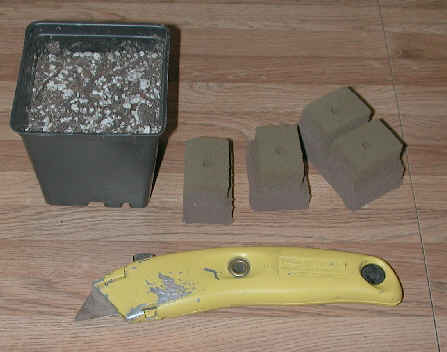
Good drainage:
Using the
knife, cut all four corners out of the pots, the
provided drain holes are NOT enough.
MJ does not
like "wet feet".
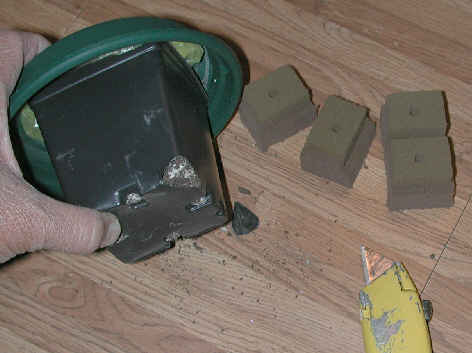
Plant the Oasis cube:
Now dig
a hole in the pre-moistened soil mix deep enough to bury
an Oasis cube nearly all the way in. You should finish
with something like this...

Prepare the cloning solution:
Now we should prepare our cloning solution. I use
Olivia's Cloning solution and gel, per instructions; it
works quite well. Start by mixing 3 tablespoons of the
cloning solution (large bottle) with 1 quart of pH
adjusted water (anywhere between pH 6 and pH 7 is good).
Add one teaspoon of hydrogen peroxide (3% solution) to
the mix to "supercharge" it. Set some of the solution in
a separate container in the refrigerator to chill.

Prepare the cuts:
Now to the mum chamber to select a cut. Show is an
Aussie Bush female mum. I should have trimmed the
prospective cut YESTERDAY and given it a day to "heal
and recuperate" before final removal. I'll cheat for the
sake of continuity. Let's try the left secondary.

Like I said, this part should
have been done 24 hrs ago..
Also, for you "mummers"
out there, you can see that I have ruined the left
secondary as a future clone site. By removing the first
(lowest) node as well as the clone (it's for science!),
I have effectively killed the left secondary. Leave that
first node alone!
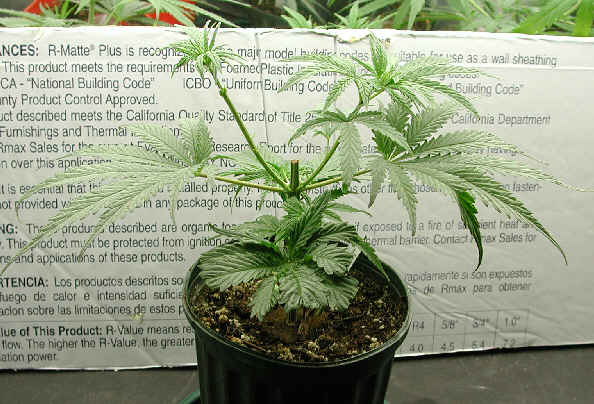
Take the cutting(s):
Now take
the cut at a 45 degree angle, and pop it directly into
the slightly chilled solution. Let it soak and uptake
solution for 10 to 20 minutes. Please note the
exacto-knife and the alcohol wipe, remember, this is an
OPERATION! Wash your hands carefully and sterilize the
cutting blade after EACH cut. Also, a new blade is
recommended for every cloning session.
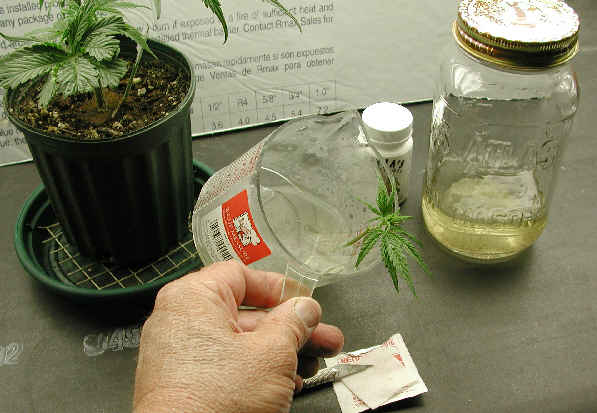
Re-cut the clone and place it in a small
amount of the cloning gel. Let it soak and uptake gel
for 10 minutes or so. *PLEASE NOTE* DO NOT dip the cut
into the whole bottle. Any viruses or other nasties you
may have on the cut WILL contaminate the entire bottle
and thus ruin all future cuts you try to make from that
bottle.
Finally, roll the cut around in the gel
to thoroughly coat the outside of the stem for an inch
or so; try to "pick-up" as much of the gel as you can
with the stem as you transfer the cut to the Oasis cube
you have prepared.
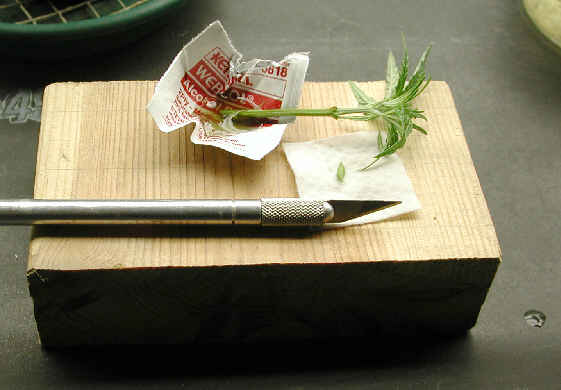
Inserting the cuts:
After
"stabbing" the cut slightly down (about 1/2") into the
bottom of the hole in the cube, slightly pinch the side
of the cube to "close" the hole around the stem. Gently,
gently please! Now, irrigate the entire pot thoroughly
with cloning solution until it runs out the bottom.
She is now ready to go into the cloning domes.
As you can see, I use two clear plastic tubs to form one
dome assembly. They are not airtight, but we don't want
that anyway.
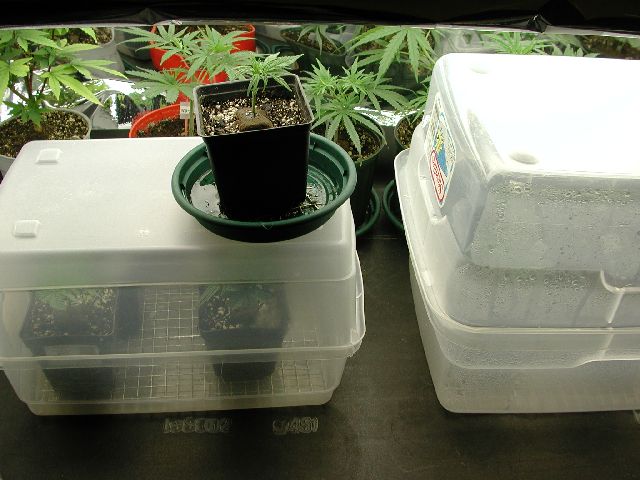
The mum & cloning chamber enjoys
year round temperatures between 74 and 76 degrees, just
about exactly perfect. Above 80, fungus and rot become
bigger problems. Below 70, and the clone just "stalls"
and takes FOREVER if it makes it at all. Be SURE to
remove the domes at least once (twice is better) every
day for a few minutes to allow "new" air in. Mist
slightly every time and water only with cloning solution
when the dirt is starting to dry a bit or the clone
starts to wilt.
Lighting:
Clones have
a limited energy "budget", only what they "contain" the
instant they are cut. Almost all of that energy is
needed just to establish good rooting. Strong light
forces photosynthesis, thus food production,
transpiration and other process not needed for rooting.
For this reason, lighting should be kept quite soft and
diffuse until the clones fully root. When using fluoros,
keep the tubes about 6" to a foot above the top of the
domes. With HID lighting, stay well back, 3 to 5 feet or
more (depending on wattage of the light) and shade the
dome from the intense HID lighting. I like to use a
white paper towel on top of the domes to further diffuse
and soften the light. Clones need VERY little light
until they root. Just insure they are getting at least
18 hours of light each day and 24/7 is ok too.
Hardening off: (getting them used to
being without the dome)
After about a week, start
leaving the dome off for a few minutes longer each day.
Monitor the clones carefully and replace the dome after
misting if they start to wilt. DO NOT forget that you
have the dome off. A young batch WILL wilt severely and
might die if not caught in time. After several
"hardening" sessions, the domes may be left off all
together (as long as there is NO wilting). There she is
on the lower right...
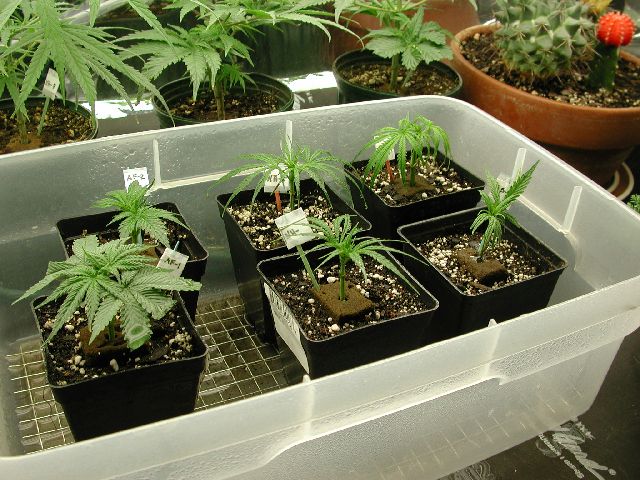
Special Technique: Trimming fan
leaves.
In this example, the clones shown are
Crystal Light x AK47 (unsexed).
The fans were
trimmed prior to setting them in the cubes because they
were already quite large and lush when the cuts were
taken, experience will tell you when you have "too much"
leaf surface and the clone will just wilt and resist
efforts to revive it. So, trim the big stuff before
"stabbing it". If it remains "wilty" remove the largest
trimmed fans completely, this usually does it for
stubborn ones. You can even then trim the smaller fans
if you REALLY are trying to save a "special" clone.
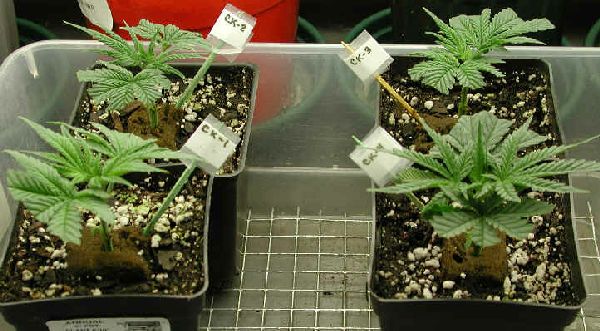
Tip 1: When are they
starting to root?
Please compare this picture
with the picture, 2nd above. Please note that now all of
the clones pictured (except our "new" AB clone) have
leaves that are strong and turning upward, as compared
to the previous photo when they were all "wilty". This
is a sure sign that the clones have started rooting, you
will also see new growth starting form the grow tips.
The 5 older clones in the photo are now ready to be
"hardened off" gradually, and finally removed from the
cloning chamber and placed in full vegetative mode.
Also, please note the grid wire at the bottom of the
tub. It works great to keep the planters out of the
water.
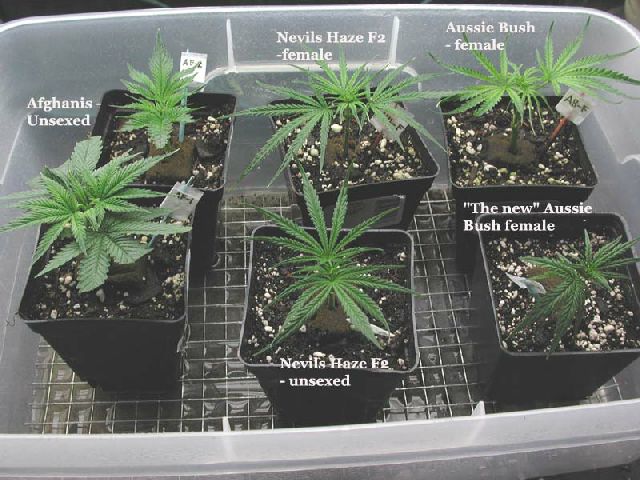
Tip 2: Humidity control under the
dome
This is a good idea for you folks that are
too busy to keep an eye on things a least twice a day.
Just put an air stone in some water in a container
inside the dome as shown. The humidity will be kept at a
nice level and you will not need to mist the clones at
all. Please notice the wire mesh is still used to keep
the planters out of any standing water; in this case,
the whole thing is set on a couple of bricks inside the
tub.

Here we see the "humidifier tub" in
action. After just a few minutes, the humidity is 75%
and the temp is 78 degress f. I will try to reduce that
"inside" temp to a steady 75 or 76 degrees. Please note
that the white lid for the tub is serving as a perfect
light blocker/diffuser.
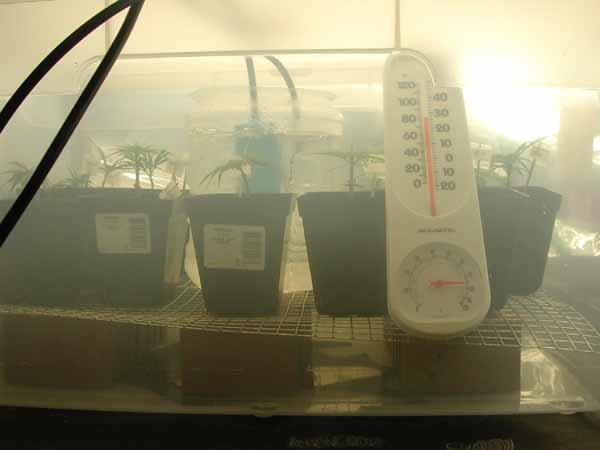
Final Tip and Credit: Oldtimer1's
ezine articles on cloning and bonsai mums!
Taking cuttings from old mums is "the way" to
duplicate great results. Once you find the magic mum,
you just grow out her cuttings for more of the same
great smoke. It is far beyond the scope of this article
to go into mums, but let me expound the excellence of
OldTimer1's article on
cloning
and
making
mums.
|